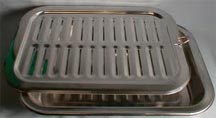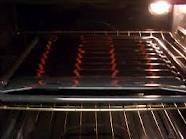Cook'n Basics: Broiling Meat & Warming Food
By Alice Osborne
Sometimes the difference between "OK" and "WOW!" is just knowing simple techniques. For instance, there's a definite technique to broiling meat, and when not done properly, meat comes out anything but "WOW!" Likewise, there's a simple technique to keeping food warm prior to serving, and when done properly, your dishes will be worthy of oohs and aahhs, rather than polite nods.
 The first step to successful broiling is to position everything properly. You'll need a large, shallow pan with a rack - most oven/stoves come with a broiler pan and rack. But one can easily be created using a large jelly roll pan with a cooling rack placed in it. Then place the meat on the rack. Position the pan below the heat source in your broiler, adjusting the pan (or the oven rack on which the pan is resting) until the top of the meat is the recommended distance below the heat source (usually explained in the recipe or entree instructions).
The first step to successful broiling is to position everything properly. You'll need a large, shallow pan with a rack - most oven/stoves come with a broiler pan and rack. But one can easily be created using a large jelly roll pan with a cooling rack placed in it. Then place the meat on the rack. Position the pan below the heat source in your broiler, adjusting the pan (or the oven rack on which the pan is resting) until the top of the meat is the recommended distance below the heat source (usually explained in the recipe or entree instructions).
 Now here's the step most folks don't know to take: Once the recommended distance is determined, remove the meat from the broiler, leaving the pan and rack inside. Preheat the broiler for 5 to 7 minutes. While the broiler is preheating, slash through the border of fat (if your meat has one) to the lean meat at 1-inch intervals to prevent the piece of meat from curling. Remove the pan from the broiler and lightly grease the hot rack.
Now here's the step most folks don't know to take: Once the recommended distance is determined, remove the meat from the broiler, leaving the pan and rack inside. Preheat the broiler for 5 to 7 minutes. While the broiler is preheating, slash through the border of fat (if your meat has one) to the lean meat at 1-inch intervals to prevent the piece of meat from curling. Remove the pan from the broiler and lightly grease the hot rack.
NOW it's time to place the meat on the rack and broil, turning as needed, for the time specified in the recipe or until it's done to your liking when given a test-cut in the thickest portion.
When it comes to keeping cooked food warm, the trick is in a tent made of foil. This will keep things nicely warmed without overcooking anything. Simply tear off a piece of foil large enough to loosely cover the platter or bowl of food.
Make a tent by placing the foil, shiny side down. Keeping the shiny side down reflects heat downward, over the food.
 Now here's the step where most folks make the mistake: Do not tuck the foil edges under the platter or tightly around the bowl. Doing so will cause the steam to gather and create condensation, which will then drip into the food and make it watery. This seems contrary to common sense, I know. But I'm ready to follow these instructions from the pros because just as it says here, my warmed food has ended up watery. Better meals are ahead!
Now here's the step where most folks make the mistake: Do not tuck the foil edges under the platter or tightly around the bowl. Doing so will cause the steam to gather and create condensation, which will then drip into the food and make it watery. This seems contrary to common sense, I know. But I'm ready to follow these instructions from the pros because just as it says here, my warmed food has ended up watery. Better meals are ahead!

